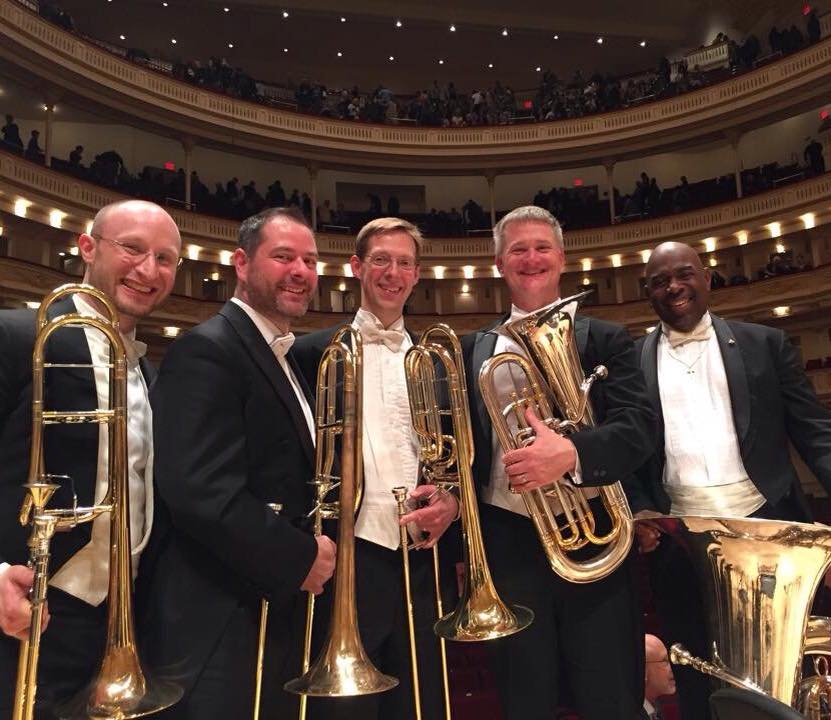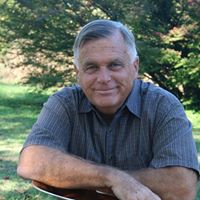Fourth Valve 2017
James Jenkins
7. In addition to your regular position with the Jacksonville Symphony, you
have had the opportunity to perform with several notable orchestras. Ahat
stylistic and listening approaches have you noticed that are distinct
between Boston, Cleveland & Jacksonville? Similar?
The basic concepts are similar between the orchestras. There is much more
of a commitment to listening, and fine ensemble playing that happens in the
highest quality orchestras. Cleveland has an unparalleled commitment to the
Chamber Music Principals. They believe in precision ensemble, clarity and
transparency in the ensemble, dynamic range (especially soft), and perfect
intonation. Boston plays with glorious sounds and many colors. They also
play with a great deal of Power! In Jacksonville, we are working on
developing all of these things to be on a similar level of the Clevelands
and Bostons.
8. Who are your inspirations?
Musical-
I’m inspired by the Great Communicators and by people that I have seen grow
to great success. A few of my musical inspirations are: John Stevens,
Wynton Marsalis, Yoyo Ma, Ella Fitzgerald, Ray Charles, Demondrae Thurman,
and Mike Roylance.
Non-musical-
Those who are creative and determined to help make things better, or to
develop something interesting and beautiful. Too many people to name.
Read the rest of James Jenkins interview here…
Warren Deck
1. What was it like to be part of the recording “Made in the USAâ€, and other projects with the Canadian Brass and members of the Boston Symphony Orchestra Brass and The New York Philharmonic Brass?
These projects were some of the most fun musical times I had. Getting to hang out with great players who were fun to be with whether we were playing or not was a particular joy. I had a sense during the recordings that these were special times. A couple of years ago, I was talking with Ronnie Romm and letting him know that those times together produced some of my fondest musical memories. He told me he felt the same way. I found it very gratifying that I was not alone in having that feeling.
2. Perhaps the inspiration for this project was the Antiphonal Music of Gabrieli with Brass from the Philadelphia Orchestra, Chicago Symphony and Cleveland Orchestra. What were/are your observations on that project and the influence that it had on your career?
Funny you should mention that recording as I literally burned out two LP’s of that recording from listening to it so much. I got my first one when I was in high school and was completely blown away. It got to the point where I could know which tuba player was playing after about two notes. The really cool thing about that recording (now that I have it on CD) is that 47 years later, I am still blown away by how well all of those people played. I would play along with that recording and knew it by rote and constantly used it as a reference recording whenever I got a new horn or mouthpiece. If I could play in tune with that recording, I felt safe in using the new equipment.
3. As you matured as a performer did the type/characteristics of the specific tuba you played on become more or less important?
They became more important. I view equipment like a shoe. A shoe you might want for playing basketball will be very different from a shoe you would want for climbing a mountain. While the equipment will never be a substitute for good skills, there is truth in having the right tool for the job. As you try for a broader range of musical expression, more and different types of “toys†can be quite helpful.
Read the rest of Warren Deck’s interview here….
Chester Schmitz
4. Who were your biggest musical inspirations? What did you learn from each?
Rostropovich, Dietrich Fischer-Dieskau, and Richter. I listened and studied them during my college years. Eventually I performed with Fischer-Dieskau, heard Richter play 2 recitals live, and played many concerts with Rostropovich. Magnificent musicians!
5. How important is a warm up, and how has yours changed over the years?
Playing properly is almost infinitely more important than requiring a specific warm-up.
Lip slurs are everything, when done properly.
BONUS! BREATHING MADE EASY, by Chester Schmitz
BREATHING MADE EASY-1
When preparing to play an instrument, if you are inhaling only through the mouth, you can add approximately 1/4 more quantity of air, and breathe much more quickly and quietly, by adding an “open nose†to the process. Nose-breathing is also the way you breathe — automatically — all day long…..to sustain your life.
BREATHING MADE EASY – 2
For those of you, particularly tuba players, who drop your jaw and form your oral cavity so as to say, “hooooo,” or, “huuuuuu,” will find that when you inhale using your nose as well as your mouth, that it will be almost physically impossible to form those vowel sounds. This is OK. One should not drop the jaw to breathe, nor should they use those vowel concepts. The correct concept is, “aaaaaaaaahhhh,” with a relaxed tongue and shoulders down.
BREATHING MADE EASY – 3
If you want to inhale silently, and take in a given amount of air more easily, and more quickly, engage the nasal passage (the nose) when inhaling. Doing this then makes it possible to set your emouchure, with playing pressure, before you breathe, top and bottom center on mouthpiece rim, so that you, after your breath, are immediately ready to make that sound…..accurately and precisely…..and musically. Air comes in at “corners†of the mouth and through the nose. It is not only very easy, but it also is the correct way to prepare and breathe in order to play any brass instrument.
c. 2017 Chester Schmitz
Used by permission.
Read the rest of Chester Schmitz interview here…
Jerry Young
Outside the arena of repertoire with piano, my favorite setting is brass quintet, hands down.
The reason?
It’s the repertoire.
As a brass quintet player, I inherited the repertoire that either came to light or was composed in the 1950s and 1960s. The Ewald quintets, the transcriptions by folks like Robert Nagel and Robert King, the compositions inspired by the New York Brass Quintet (such as the Bozza “Sonatineâ€), the Malcolm Arnold “Quintet,†and so on. The first professional brass quintet I heard was on a recording by the Philip Jones Brass Ensemble, featuring the late John Fletcher on tuba, and the recording did indeed feature the “first†Ewald quintet and the Malcolm Arnold. I was inspired both by the repertoire and John’s virtuoso performance.
In the early 1970s the Eastman Brass Quintet (Cherry Beauregard on tuba) came to my university – that was the first live performance I heard by a professional group. I immediately bought their record album and learned all the tuba parts. Hearing that group led to the formation of a student brass quintet and my own first experience. After that time, I have been associated with a brass quintet of some description throughout most of my life. And the repertoire has continued to grow – there is always more there, both in terms of the basic instrumentation and exploration of the basic instrumentation with additions. In the most active years of my career, new works from Jan Bach and Eric Ewazen were extremely exciting for me (and others, too). The satisfying musical possibilities seem to be almost infinite – witness the adventures of the Dallas Brass and the Mnozil Brass. This is not to mention the vast contributions to the repertoire of the Canadian Brass. None of us will ever be able to perform all of the top-drawer repertoire that is available.
 2. How does one feed their musical soul when college or high school is over, and the steady playing that comes with it?
2. How does one feed their musical soul when college or high school is over, and the steady playing that comes with it?
Who said that steady playing has to stop?
I currently play in a community band in Traverse City, Michigan that is loaded with folks who are music teachers (as well as representatives of a variety of other professions) who are serious players. And this is one of TWO bands in a basically rural area of Northwest Lower Michigan! Not to mention a symphony orchestra (I know – only one tuba, but…) and two brass bands in our region of Michigan.
I play in a euphonium/tuba quartet (rehearses weekly) with three other retired musicians, and my wife and I play in a ragtime quartet, too! And there are multiple brass quintets, woodwind quintets, string ensembles, vocal groups.
I believe that there are musicians all around us who really want to continue to make music, but in the course of their busy lives, no one has asked them to play. One can feed one’s musical soul by finding and motivating other musicians to play with them. If one is SO isolated that there simply is no one around to share the performance experience, there is a lot of great music (regardless of one’s instrumental voice) for solo instruments waiting to be played – even if it is for oneself. That’s another option along with intent and involved listening to the vast musical offerings on the airwaves and digitally.
3. Which live performances of music have inspired you the most?
This is a “killer†question… With over fifty years invested in intense listening and performing, I’ve experienced a lot of inspiring moments. To humor the question, I’ll describe just a few “great performances†briefly:
• The Beaux Arts Trio – I heard this group in the early 1980s in Kansas City. Listening to and watching Mr. Pressler at the piano was an amazing lesson in expressive legato playing that has affected my own playing ever since.
• A live performance by Harvey Phillips in 1978 with my wife at the piano. They performed Sondheim’s “Send in the Clowns.†There was not a dry eye in the house by the time the performance ended. Musical/emotional communication at its very best.
• My first performance as a member of the faculty at the National Music Camp (now the Interlochen Arts Camp). I found myself performing Gabrieli canzoni with former principal trumpet of the Philadelphia Orchestra, Gilbert Johnson, and with former principal trombone of Philadelphia, Henry Charles Smith (sitting next to me) on euphonium. After all the years of listening to “The Brass of Three Great Orchestras,†I felt somewhat out of place, but what an exciting and inspiring moment.
More Jerry Young interview here…
Roland Szentpali
 1. How did you meet the saxhorn, and was it a good thing or a bad thing?
1. How did you meet the saxhorn, and was it a good thing or a bad thing?
I started to do research on the previous instruments which led to the tuba; this is how I met first the French Tubás, including saxhorn. It is a great instrument!
2. What are your three favorite cities, and why?
Budapest, because of its compact size and architecture. The colorful culture and the nightlife.
Bologna, because of the architecture and the culinary arts.
Luzern, because it’s just simply beautiful
3. What does it take to make it through your warm up, and how has it changed since college?
I didn’t do a daily warm up, every day is different.



